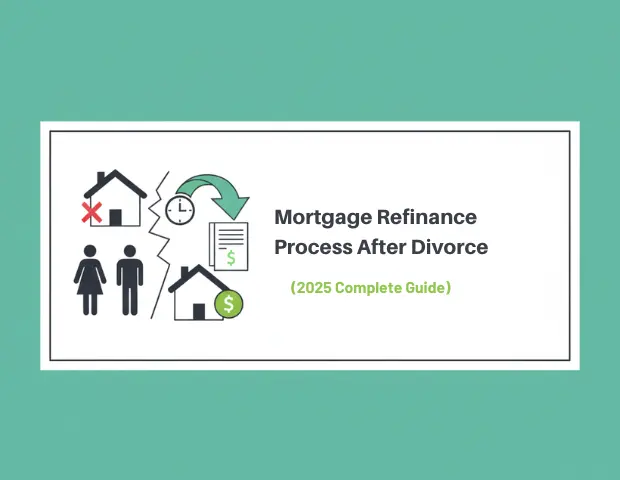
Key Takeaways
- In Minnesota divorces, if one spouse keeps the home, refinancing in their name alone is almost always required and should happen promptly—ideally before the divorce is finalized for least complication.
- Most lenders require a new mortgage application subject to standard income, credit, debt, and equity rules. Only the new sole owner’s finances are considered after divorce.
- If support income (alimony, child support) is needed to qualify, provide at least six months’ (conventional) or three months’ (FHA) proof of consistent, court-ordered payments and proof they’ll continue for at least three years.
- Your Marital Settlement Agreement or divorce decree must include timelines, buyout amounts, default contingencies (“sunset” language), and arrangements for missed payments or ongoing support.
- Missed mortgage payments hurt both parties’ credit and can kill the refinancing process.
- For tailored, expert guidance, contact mortgageforest.com/divorce-mortgage/ or call (612) 590-7896.
A marital home is a cornerstone of every divorce. If you—or your ex—want to keep the house, the process of refinancing during or after divorce can seem overwhelming, but it protects credit, cleanly divides financial responsibility, and often fulfills your court obligations.
Why Is Mortgage Refinancing Required?
- Protects the departing spouse from future liability and credit risk.
- Meets lender requirements—almost never can you “just remove” a spouse from an existing loan (except for some assumptions and rare releases of liability for certain government-backed loans).
- Provides a clean buyout through a cash-out refinance or arrangement with other marital assets.
When to Refinance: Timing Is Everything
1. Before Divorce Is Filed
- Easiest by far. Status is “married,” so most lenders only require the new solo borrower to qualify, and a quitclaim deed is performed at closing removing your spouse from the title.
- No court paperwork necessary at this stage.
2. During Divorce Proceedings
- More complex. Lenders require a draft or signed Marital Settlement Agreement spelling out all obligations, buyout amounts, deadlines, and support schemes.
- Both spouses’ cooperation is required for paperwork and signatures.
3. After Final Decree
- Most complicated. You must provide the final, signed divorce decree and Marital Settlement Agreement, with precise terms about buyout, timeline, and support.
- Your finances—assets, income, debts, support—will be re-evaluated as a solo applicant.
Documentation Required
- Marital Settlement Agreement: Specifies who keeps the home, how it’s paid for (buyout amount or other assets), deadlines, and remedies for missed payments.
- Divorce Decree: Proves finality and legal standing.
- Mortgage Statement/Payoff Quote, Income Documents, Credit History, Title Work.
- Proof of Support Payments: 6 months for conventional or 3 for FHA (showing on bank statements or court ledger); must show continuation of at least 36 months.
How Lenders Assess You After Divorc
- Only the new owner’s income, debts, and credit are considered.
- Support received must be court-ordered, paid reliably, and projected to continue, or it won’t count as income.
- Debt-to-income ratio will include any court-ordered support paid out by the borrower.
- Missed mortgage payments kill all chances—keep current at all times.
Setting Deadlines and Default Protections
- “Sunset language” protects the departing spouse from risk: if the new solo owner misses a payment (often 60 days late), that triggers an automatic agreement to sell the property.
- Payment direction: Some agreements allow a support-paying spouse to make mortgage payments directly to ensure it remains current if the other falls behind.
Alternatives If Refinancing Fails
- Sale: Both parties split the proceeds based on the settlement after mortgage, taxes, and repairs.
- Asset Offset: If the retaining spouse cannot refinance, sometimes a trade is engineered for other assets (e.g., investments, retirement accounts), documented in the agreement.
- Mortgage Assumption or Release of Liability: Only for select FHA, VA, or USDA loans, and at lender discretion.
- Non-QM Lenders: If you lack traditional work history, some lenders may approve a refinance if you have 20% or more equity.
Common Mistakes
- Believing your lender will “just take someone off.”
- Ignoring the mandated deadline—courts usually allow 60-120 days but may grant more if tied to a child’s milestone.
- Missing payments during the divorce.
- Not completing a quitclaim deed at the refinance closing—title and mortgage must match.
- Overlooking the effect of newly-ordered debt/support on your debt-to-income ratio.
FAQs
How does a cash-out refinance in divorce work?
You borrow enough to pay off the existing mortgage and provide your ex their fair share of the equity—often capped at 80% loan-to-value.
Can I use support as income to qualify?
Yes, if it’s court-ordered, received for 6 months (3 FHA), and verified to continue 36+ months.
What if my ex misses one of their last payments?
“Sunset” or remedy language in your settlement may allow you to direct support to the mortgage directly or force a sale at a certain threshold.
Conclusion & Call to Action
Divorce mortgage refinancing in Minnesota is a timeline-driven, paperwork-intensive process—but it is also your ticket to financial independence and credit protection. Shop for rates, protect your credit, involve legal and lending experts, and set every detail, deadline, and remedy in writing for your agreement.
To make the process smooth and secure, call (612) 590-7896 or visit mortgageforest.com/divorce-mortgage/. Get personalized, professional assistance on every step.
